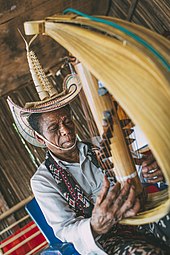Rotinese
The Rotinese ( Indonesian Suku Rote ) are one of the indigenous ethnic groups of the Indonesian island of Roti . They can also be found in the west of Timor and on other neighboring islands, such as Ndao , Nuse , Doo , Helihana , Landu , Manduk , Semau and other smaller islands. There are around 100,000 Rotinese.
history
It is sometimes believed that the Rotinese originally immigrated from the Moluccan island of Seram to their current settlement area. They arrived on Roti during the Majapahit Empire (13th to 16th centuries). There are reports of Rotinese rulers from this period. First they are said to have settled in west Timor , where they operated slash and burn to create fields and put on irrigation systems. In 1681 the Dutch conquered the island of Roti, from where slaves were brought to Timor. In addition, the Dutch recruited soldiers for their army and built schools on Roti after the local ruler converted to Christianity in 1729. The Rotinese became a well-educated elite. In order to use them as a counterweight to the Timorese, the Dutch encouraged their immigration to West Timor in the 19th century, so that they and their language are still present here today.
language
The Rotinese language, Rotinese , is one of the Austronesian languages . It is one of the Malayo-Polynesian Fabronian languages . Thus it is a closest relative of the other languages in West Timor, such as Uab Meto or Helong . Rotinese is divided into numerous dialects.
society
Nuclear families and extended families traditionally have a patriarchal character. Large families form small clans called Nggi Leo , led by a Manesio . These in turn unite in a "realm" called Leo . The ruler is called Manek or Mane Leo . Roti alone is divided into 18 individual, semi-autonomous domains, each under the leadership of a Manek . Twelve of the "rich" are mentioned by the Dutch as early as 1662. There is no overarching traditional ruler of the island. The Rotinese do not refer to a common ancestor and each “empire” has its own traditional law, its own dialect and its own clothing styles. The main role of the manek is that of judge in local disputes. Much of the political structure is still preserved today. The Maneks are integrated into the administration as civil servants by the Indonesian government. In addition to their arbitration function, they collect taxes and pass on national guidelines to the population.
The Rotinese society is divided into the class of the nobles and the common folk, the louse . Lau is derived from the root of the word, which is associated with illness, ugliness and unhappiness. There is no hierarchy within the louse clans ; but each clan has its own ritual privileges, for example performing a minor thanksgiving ceremony or the first shot in a battle. In the case of the nobles, there is again a difference between the Manek clan and the Fetor clan , the executive prince. The name is derived from the word Feto for "woman", Manek comes from the word Mane for "man". The concept of dividing power according to symbolic sexes can also be found among the ethnic groups in Timor.
Marriage outside one's own clan ( exogamy ) is common. The woman usually lives with the man's family (patrilocal) .
religion
In traditional beliefs, a creator, ruler and blesser named Lamatuan or Lamatuak was worshiped. He was symbolized with a stake branched into three parts. Today, however, most Rotinese are Protestant or Catholic Christians or follow Islam.
Objects

Traditional Rotinese clothing is called cain , a 2.5-meter-long cloth that is wrapped around the waist and goes down to the knees or ankles. There are also jackets and shirts and a striking straw hat, the Tii Langga .
The traditional musical instrument is the sasando , a bamboo zither.
economy
The traditional livelihood of the Rotinese includes agriculture, cattle breeding, fishing, the extraction of palm sap and the processing of palm wood. Artificial watercourses are used to water rice fields and create retention basins. In addition to rice, maize, cassava and millet are mainly grown. Pepper, peanuts, vegetables and coffee are also harvested. Water buffalo, cattle, horses and poultry are used as farm animals. Rotinese women traditionally weave and plait pandan leaves . There is also pottery. There is also some trade going on.
Web links
Individual evidence
- ↑ Navita Kristi: Fakta Menakjubkan Tentang Indonesia; Wisata Sejarah, Budaya, dan Alam di 33 Provinsi: Bagian 3 , Cikal Aksara 2012, ISBN 602-8526-67-3 .
- ↑ a b c d e M. Junus Melalatoa: Ensiklopedi Suku Bangsa di Indonesia Jilid LZ , p. 713, Directorate Jenderal Kebudayaan.
- ↑ a b c T. O. Beidelman: The Translation of Culture: Essays to EE Evans-Pritchard , p. 40 ff., Limited preview in the Google book search
- ↑ a b c d e Zulyani Hidayah: Ensiklopedi Suku Bangsa di Indonesia , p. 327, Yayasan Pustaka Obor Indonesia 2015, ISBN 97-946-1929-9 .
- ↑ a b c d Бернова А. А. & Членов М. А .: Народы и религии мира. Энциклопедия , p. 433 М .: Большая Российская энциклопедия 1999.
- ↑ Jane's oceania - Timor
- ^ The Languages of East Timor: Some Basic Facts ( January 19, 2008 memento in the Internet Archive )
- ↑ a b Архипов В .: Культура народов острова Тимор в Индонезии , pp. 31–44, Азия и Африка сегодня, Ежемес. Науч. И обществ.-полит. Журн, No. 2 1996.
- ↑ a b Юрия Васильевича Маретина: Народы мира. Этнографические очерки: Народы Юго-Восточной Азии , p. 575, Издательство Академии наук СССР 1966.
- ↑ Shelbi Asrianti & Yudha Manggala P Putra: Sejenak Melenggang di Kupang , November 11, 2017 , accessed on April 16, 2018.
- ↑ Mustafa Iman: Menyambangi according to mati di Rote , August 2, 2017 , accessed on April 16, 2018.


